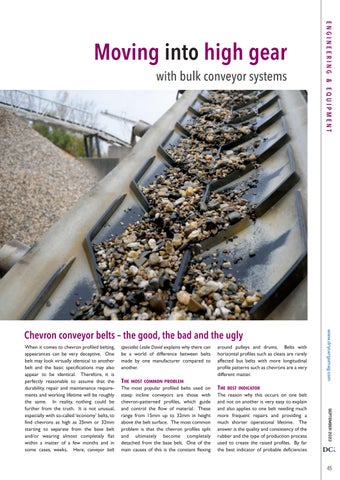with bulk conveyor systems
specialist Leslie David explains why there can be a world of difference between belts made by one manufacturer compared to another.
around pulleys and drums. Belts with horizontal profiles such as cleats are rarely affected but belts with more longitudinal profile patterns such as chevrons are a very different matter.
THE MOST COMMON PROBLEM The most popular profiled belts used on steep incline conveyors are those with chevron-patterned profiles, which guide and control the flow of material. These range from 15mm up to 32mm in height above the belt surface. The most common problem is that the chevron profiles split and ultimately become completely detached from the base belt. One of the main causes of this is the constant flexing
THE BEST INDICATOR The reason why this occurs on one belt and not on another is very easy to explain and also applies to one belt needing much more frequent repairs and providing a much shorter operational lifetime. The answer is the quality and consistency of the rubber and the type of production process used to create the raised profiles. By far the best indicator of probable deficiencies
SEPTEMBER 2023
When it comes to chevron profiled belting, appearances can be very deceptive. One belt may look virtually identical to another belt and the basic specifications may also appear to be identical. Therefore, it is perfectly reasonable to assume that the durability, repair and maintenance requirements and working lifetime will be roughly the same. In reality, nothing could be further from the truth. It is not unusual, especially with so-called ‘economy’ belts, to find chevrons as high as 25mm or 32mm starting to separate from the base belt and/or wearing almost completely flat within a matter of a few months and in some cases, weeks. Here, conveyor belt
www.drycargomag.com
Chevron conveyor belts – the good, the bad and the ugly
ENGINEERING & EQUIPMENT
Moving into high gear
DCi 45
